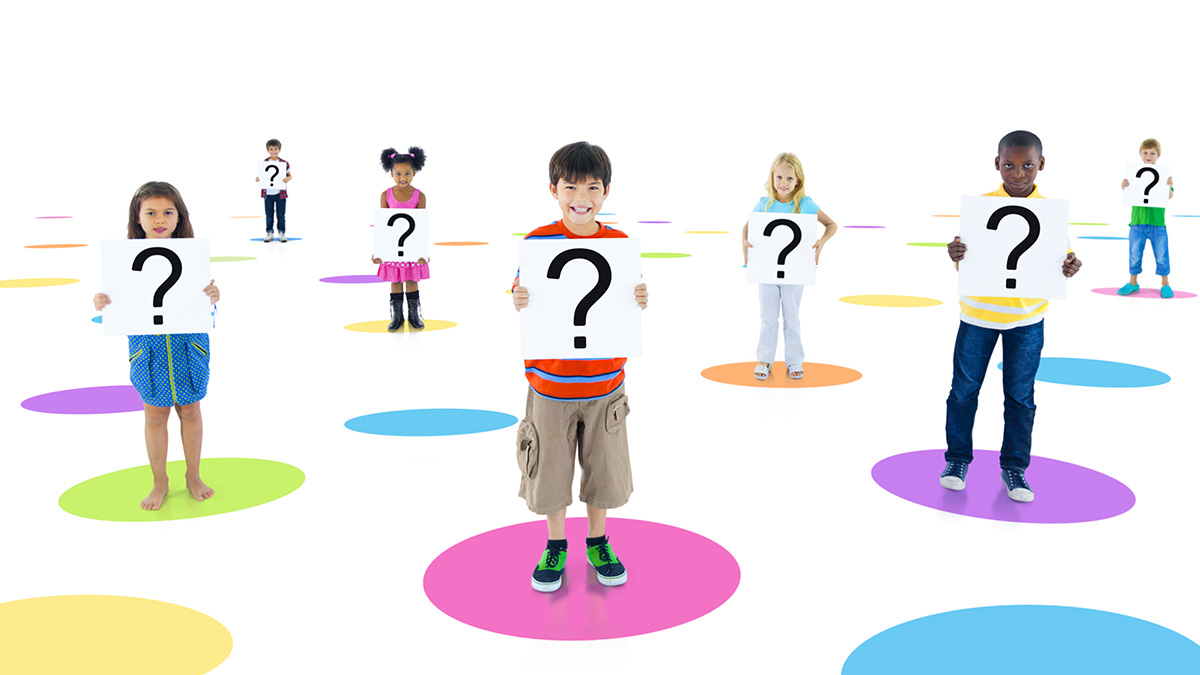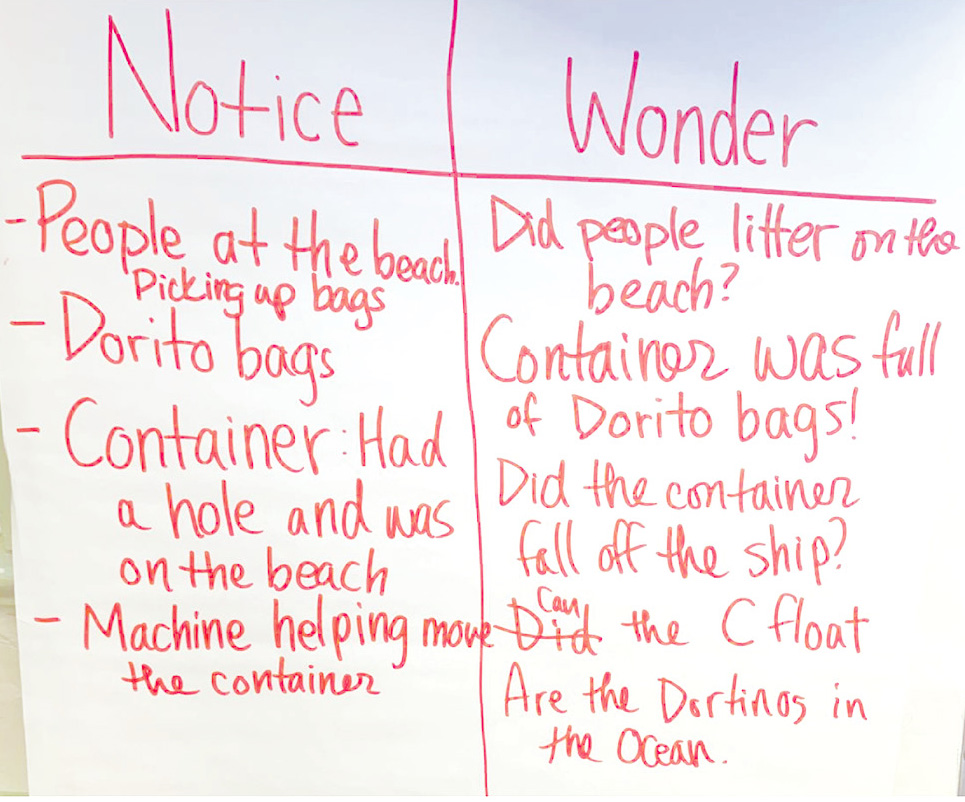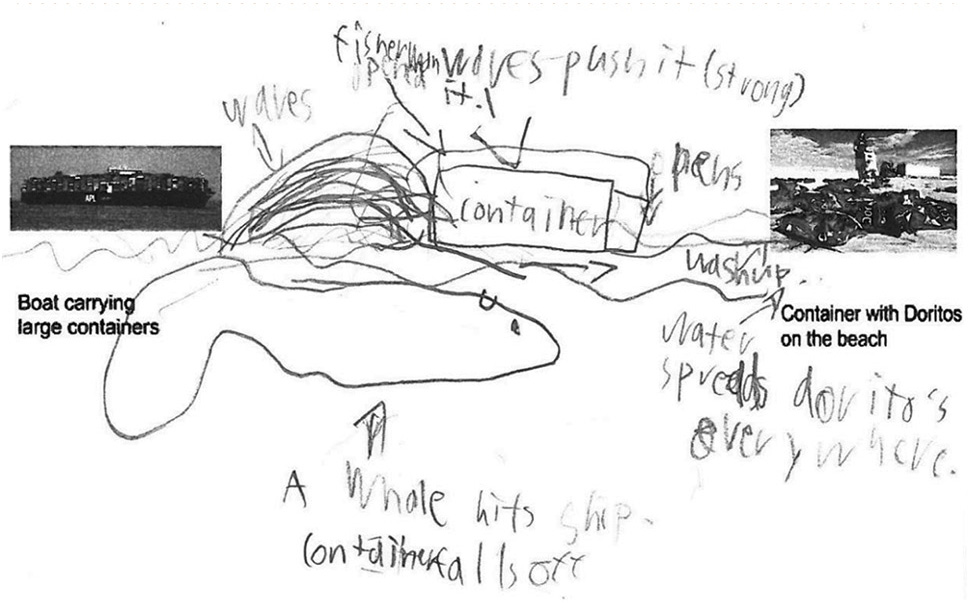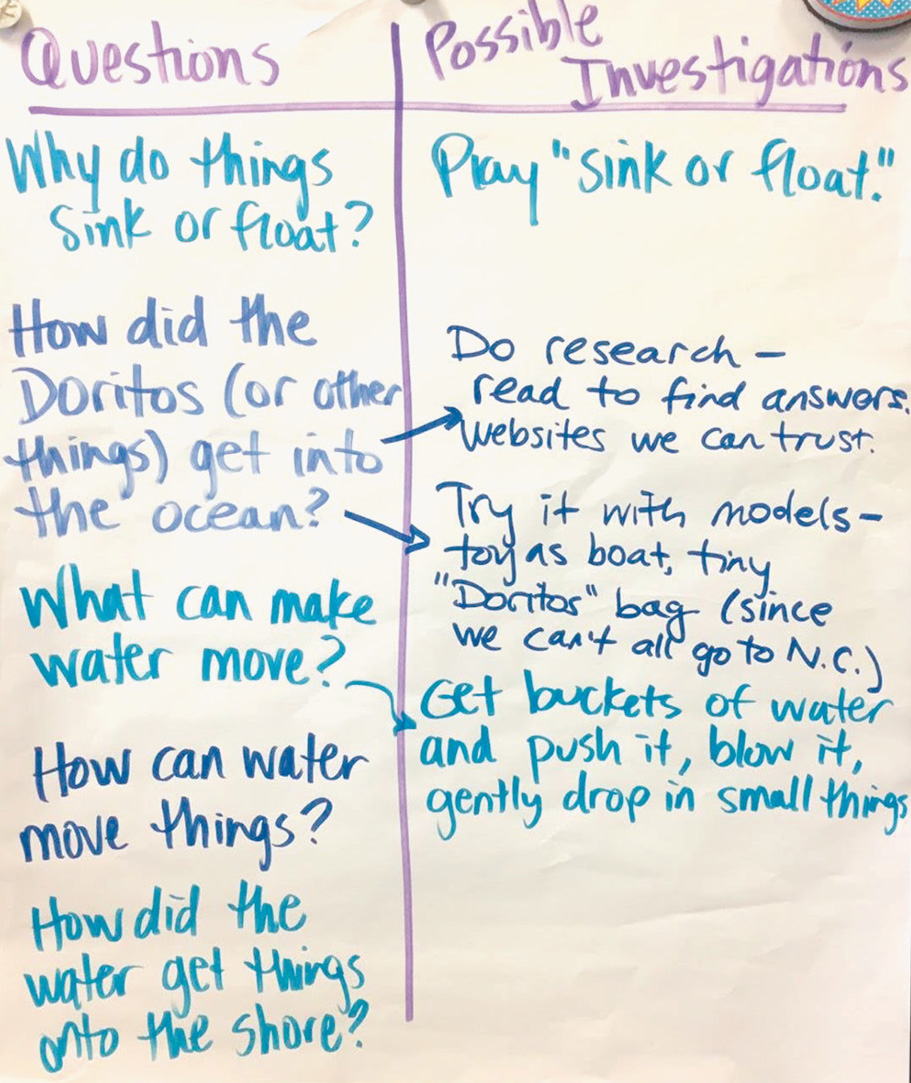feature
Motivating Three-Dimensional Learning From Students’ Questions
Supporting elementary students’ three-dimensional learning about waves with a storyline unit
Science and Children—September/October 2021 (Volume 59, Issue 1)
By Tara A.W. McGill, Gail Housman, and Brian J. Reiser

This is an exciting time for science education. The Next Generation Science Standards call for three-dimensional learning—where students use science and engineering practices to build and apply disciplinary core ideas and crosscutting concepts. Using these practices involves figuring out how phenomena work and solving problems, rather than learning about the science and engineering that others have figured out (Schwarz, Passmore, and Reiser 2017).
But for students to be truly engaged in these practices, they must undertake meaningful intellectual work themselves. Using the practices in three-dimensional learning means that a classroom community of students working alongside the teacher identifies questions and debates how to make progress. Students should see each step of their work as addressing goals they have set. If students are busy exploring floating objects in bins of water and we ask, “Why are you working on this?” they should answer with what they are trying to figure out and why that question matters to them—not simply that the teacher or textbook asked them to do it.
How can teachers help students raise questions from phenomena? How do we help students investigate their questions so that they develop the targeted science ideas? In this article, we explore a strategy developed by researchers and teachers for supporting three-dimensional learning called storylines (Reiser et al. 2021, forthcoming). A storyline is a multi-lesson unit where students see the science work they are doing as addressing questions and problems that their class has identified. The motivation for each lesson emerges from the questions students have identified and where they left off previously, and teachers support students in developing science ideas over time.
We explore the storyline approach in a fourth-grade unit investigating wave properties and ocean floor structures called “Why Do Some Things Wash Up on the Beach and Others Don’t?” (McGill and Novak 2019). Using examples from several fourth-grade classrooms, we consider how teachers partner with and support students as they develop questions, decide how to investigate them, and make progress on figuring out phenomena.
Why Do Some Things Wash Up on the Beach and Others Don’t?
This seven-lesson unit was co-developed by teachers, instructional coaches, and researchers. It begins with a series of photos and a news article about people discovering thousands of bags of chips on an east coast beach. Through the unit, students work to figure out what caused all those chips to get on the shore and more generally how objects move on water.
The Anchoring Phenomenon Routine: Working With Students to Kick off Investigations
Just looking at photos or reading an article does not establish a path of questions and investigations with students. Storylines use an Anchoring Phenomenon Routine—a framework of four elements that helps teachers guide students from an initial phenomenon to questions: (1) explore the phenomenon; (2) attempt to make sense; (3) identify related phenomena; (4) identify questions and ideas for investigations.
Explore the phenomenon: The teacher shows several images of bags of chips and a damaged shipping container that have washed up on a beach. The teacher asks students, “What do you notice? What do you wonder? What caused this to happen?” and scribes for the class (Figure 1) but refrains from evaluating students’ responses other than to push for more detail. There are no right or wrong answers here; all ideas are valued. Figure 2 shows one teacher supporting students in brainstorming a broad range of ideas about possible causes. Varying ideas begin to emerge. Some students have ideas about how smaller objects like bottles or shells could wash up on shore, but this container is the size of a truck. Now the class has a problem to solve.

The teacher supports students’ brainstorming about the anchoring phenomena.
Maria: Maybe there was like a storm and then somebody was driving a truck and then maybe like it crashed and then all the chips bags came out of there.
Teacher: I mean, it kind of looks like the back of a truck, and I heard you say a storm makes it hard to drive, right? And then it crashed, and then we think, we’re inferring… I’m seeing a lot of nodding heads. We’re deciding that the chips were in that truck or in that crate.
Maria: Because they go to stores, or to different countries.
Teacher: ...Lisa, what are you thinking?
Lisa: Well I respectfully disagree with Maria because it doesn’t look like there was a storm.
Teacher: Oh. What’s telling you it wouldn’t have been a storm?
Lisa: Because the sky isn’t dark. Because it’s dark after a storm.
Maria: But maybe it was like yesterday.
Teacher: Elisa, what are you thinking?
Elisa: Maybe it like, maybe like we said it fell out from a ship but instead of maybe on a party ship or something like that it would have been a cargo ship that was carrying that thing in the back ...and then something happened where it like opened or something fell out and the Doritos fell out.
Teacher: Okay. So I hear you saying maybe there was a cargo ship. Maybe there was a truck. Maybe this container was carrying Doritos and it fell off, fell out, had some kind of accident. Jorge, tell us more.
Jorge: I just had a theory that the truck went into like a boat, like one of those boats that bring in cars and stuff… I was thinking it might have been like the Titanic, like it hit something ...and then the crate was opened when the ship sank. And the Dorito bags had air in it so it probably went up and then a tidal wave probably or a tsunami picked it up, swooshed on the beach, and then that’s why all the Doritos are there.
Students realize they need more information, and they closely read a news article about the event. They find explicit details and make inferences that expand their understanding of the phenomenon (ELA CCSS.ELA-Literacy.RI.4.1).
Attempt to make sense: At this point, the teacher prompts students to try to make sense of what they have figured out so far. This step provides students the opportunity to consider their conversations about the phenomenon and draw initial models of what they think caused the shipping container of chips to get onto the beach (Figure 3). Some students might have found others’ ideas convincing during discussion or have further ideas when pushed to diagram what could have happened. Popular ideas across classrooms typically include being pushed by wind, moved by waves, or pulled by sea animals. The teacher celebrates the diversity of models, setting the stage for the genuine need to gather evidence to resolve these emerging disagreements.
Identify related phenomena: Next the teacher asks, “When have you ever experienced or learned about something washing up on the shore? What happened?” Experiences students have shared include “lost goggles, water washed them back up to the shore,” “baby whale on the news,” “shells washed up on the shore,” and “dolphin washed up.” Other common responses include branches and seaweed. Discussing these experiences broadens students’ thinking and helps the class see that figuring out how the container of chips got to shore might also help them make sense of other common experiences. Identifying these related phenomena creates a context for students to connect the science content to their lives.
Identify questions and ideas for investigations: In this step, students work to identify a common set of questions they want to figure out. Students individually identify questions emerging from their discussions about the anchoring phenomenon and their related experiences. Each student shares a question with the class and links it to questions others have already asked. The teacher helps the class organize their questions into clusters on a Driving Question Board (DQB; Weizman, Shwartz, and Fortus 2010). The DQB becomes a public representation of what the class wants to figure out to help explain the phenomena. (See Table 1 for a sample of typical student questions organized in clusters.)
To figure out how to take action on these questions, the teacher invites students to suggest information they need or investigations they could do in their classroom. Students brainstorm and evaluate a variety of things they could do, including research and collecting their own evidence from investigations. Figure 4 illustrates how one teacher helped students build on each others’ ideas to come up with something concrete to try. A summary of the discussion is shown in Figure 5.

| Table 1. Examples of clusters of student questions from Waves classrooms. | ||||||||||
|---|---|---|---|---|---|---|---|---|---|---|
|
The teacher helps students brainstorm ways to investigate their questions.
Teacher: What could we investigate to answer the rest of our questions? Samantha, what do you want to do?
Samantha: I think we should solve what makes the waves, because maybe that will give us “Why did the Doritos get all the way to the beach?”
Teacher: Anybody else want to add on? Samantha, call on somebody else. [Samantha points to David.]
David: We could get a bucket of water, and put in something that floats, and see if waves can push it. ons.
Navigation: Working With Students to Figure out Next Steps
Meaningful science work requires that students know and care why they are doing what they are doing, which starts with the Anchoring Phenomena Routine. Each next step requires the Navigation Routine, connecting where the class has been to where the class goes next. The teacher invites students to be partners in this work. First the class considers what they figured out last time and where they left off. Then they consider what question they need to work on next and how they can go about it.
In the Waves unit, students first explore making waves in an opaque bucket (Lesson 2). Then students identify the need to refine their process because of problems encountered using the opaque bucket, so they use a standard paddle and a transparent bin, allowing them to produce more consistent observable wave patterns. Students figure out how to use the paddle to make taller or shorter waves and waves farther apart or closer together (Lesson 3). At this point, their investigations have not considered how a floating object (like the container) interacts with waves. So, the teacher invites students to come next time with ideas for objects they would like to try floating in their wave bins. In the example shown in Figure 6, several students had proposed using zipper-seal bags to represent closed bags of chips floating on the ocean, and another student built on that idea to include the container.

The teacher and students in a navigation discussion.
Charlie: I don’t know if this is the greatest idea, but…
Teacher: We’ll take ’em all, man.
Charlie: I know all our books are in our book bins, but then I was thinking, what if we took all the books out and all the stuff that could get wet, and put in like a ... something for the chips …
Teacher: I like the idea of having some kind of container. I don’t want to get those [book bins] wet because that label on the front I don’t think would survive. Can I get you a different kind of container? ... Like a, you know, Tupperware, like a Ziploc thing? Like that?
Charlie: I want, you know, like a harder thing, not like a ...
Teacher: Yeah, not a squishy bag. Okay, I can get you that. I’ve got some in the cabinet over there.
Although the teacher plays a key role in helping students refine these ideas, students are part of identifying the need for what they are working on and thinking through ways to make progress. The teacher balances honoring students’ ownership and investment in figuring out answers to their questions while also helping the class develop target science ideas and practices.
Problematizing: Pushing Students to Go Deeper
Students predict that waves will push floating objects in the direction of the wave. They try adding a floating object (representing the container of chips) to their wave bin, and find something quite unexpected (Lesson 4). No matter what waves they make, the floating object does not get closer to the opposite end of the bin (the shore). Taller waves make the object bob up and down higher, and closer-together waves make it bob faster, but nothing pushes the object to the shore.
The teacher emphasizes this problem. One teacher said, “If the object on the waves goes up and down, up and down...how does it ever get to the shore? Why isn’t it still out there just bobbing on the waves, up and down, forward and back? What is going on?” Now the class has a new problem to solve: Why didn’t their model work as they predicted?
Their model is partially successful—students figured out how to make taller or more frequent waves. But they couldn’t extend these ideas to use waves to make objects move. Uncovering such gaps can be a real opportunity to make progress. The Problematizing Routine can help students realize where they need to push further. Rather than setting up activities so that students get directly to “the right answer,” guiding students to construct explanations piece by piece helps them build deeper understanding. Students not only see why something works but also why other explanations don’t work as well. It builds their confidence as authentic scientists.
The teacher suggests a direction for the class to take. For example, “I wonder if there’s something we’re missing about our wave tank that’s not ... a close enough model of the ocean where this container was floating. I found a really cool thing ... a website that allows us to look in real time at ships out on the ocean. I would like to take a look at that and see if we can figure out whether there is something going on where those chips were out on the ocean that we may need to add to our models, so our wave tank is more like the real ocean.”
The students discover that cargo ships stay relatively close to shore when travelling along the Atlantic coast, and they use maps to investigate that area. The class notices that the ocean water is deeper farther out and gets increasingly shallow as it gets closer to land (Lesson 5). During this discussion in one classroom, a student compared the depth pattern they’re seeing on the maps to her own experiences: “I noticed in my schema that if the waves tank was all the same size, then the waves would start going like bounce and bounce (gestures with hands back and forth). But in a wave pool they make it deep and then lower and lower and lower (gestures with hand like going up a ramp).”
Based on what they figure out from maps of the ocean floor, the class revises their wave bins by propping up one end to simulate a slanted floor, and they repeat their investigation of how waves move floating objects (Lesson 6). Now, the floating objects moved from the deeper side of the bins to the “shore!” The class celebrates their results and updates their consensus model to explain how the container and chips got onto the beach (see Figure 7). In the final lesson they extend their model to additional scenarios.

Conclusion
Storylines involve students as partners in identifying questions and problems, figuring out how to address them, and making sense of what they find. It involves attempting to balance figuring out target science ideas with granting students authentic agency. The Anchoring Phenomenon Routine helps situate the science that students figure out in their own questions and experiences connected to their lives. Navigation brings students in as participants in conversations about how to make progress. Problematizing supports students in seeing where they need to push deeper, and helps them not only learn the science ideas but see why alternatives are not adequate. Together these routines help make students’ engagement in the three dimensions of NGSS more meaningful by connecting their science work to their own questions and ideas.
This unit is freely available for download along with other elementary units at https://www.nextgenstorylines.org/elementary. ●
Tara A.W. McGill (Tara.McGill@northwestern.edu) is a Curriculum Development Specialist in the NextGen Science Storylines and OpenSciEd projects at Northwestern University. Gail Housman (Gail.Housman@u.northwestern.edu) is a Curriculum Development Specialist in the NextGen Science Storylines and OpenSciEd projects at Northwestern University and was previously an elementary teacher (grades 4 and 5) in Illinois. Brian J. Reiser (Reiser@northwestern.edu) is a professor of learning sciences at Northwestern University and member of the leadership teams of the NextGen Science Storylines and OpenSciEd development projects.
Crosscutting Concepts Disciplinary Core Ideas Interdisciplinary Physical Science Three-Dimensional Learning Elementary Pre-service Teachers


